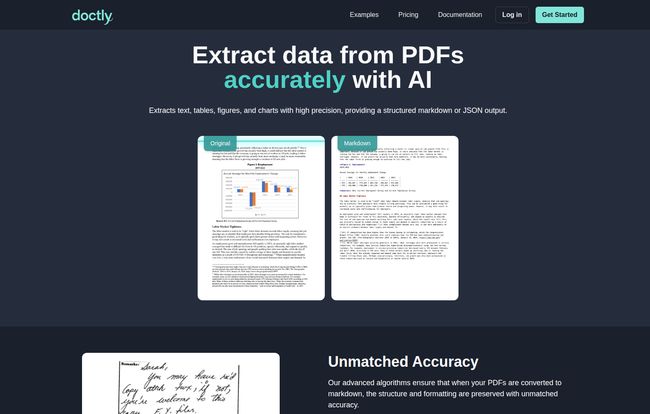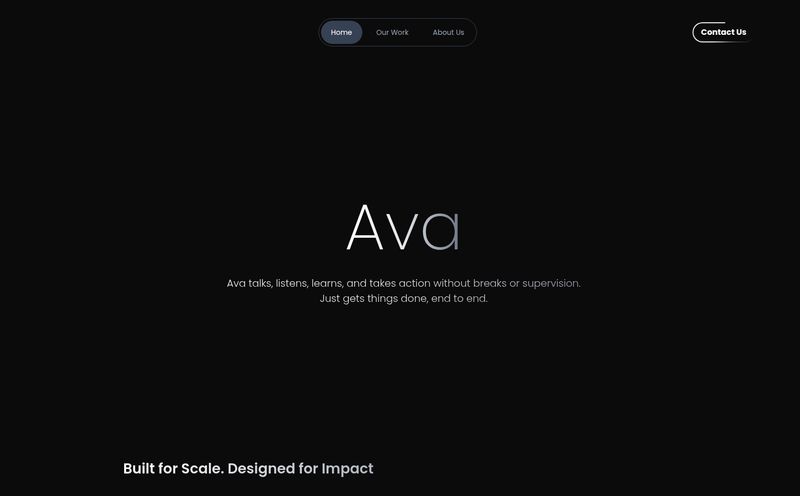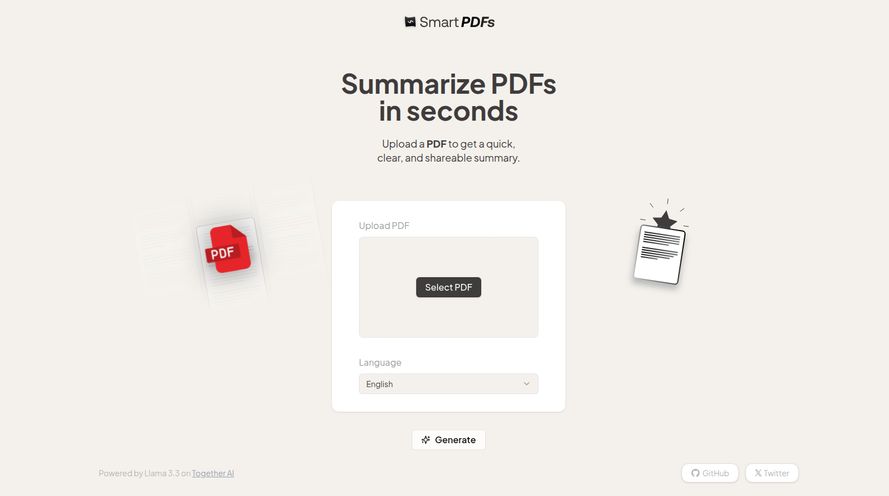If you've worked in digital marketing, data science, or really any field that involves a computer for more than five minutes, you've felt the pain. The specific, soul-crushing pain of trying to get information out of a PDF.
PDFs are like a digital roach motel for data: information checks in, but it never checks out. At least, not cleanly. You copy-paste a beautiful table from a financial report, and you get... a wall of text that looks like your cat walked across the keyboard. You try to pull text from a two-column academic paper and the lines get jumbled into complete gibberish. It's a productivity killer. For years, I’ve cobbled together solutions with clunky OCR tools and a whole lot of manual cleanup. It’s tedious, it's error-prone, and honestly, it’s a part of my job I truly dislike.
So when a tool like Doctly.ai comes across my desk, I'm naturally skeptical. But I'm also hopeful. Could this be the one? The tool that finally tames the PDF beast? I spent some time with it, and well, let me just tell you about it.
So, What is Doctly.ai, Actually?
At its heart, Doctly.ai is an AI-powered document parser. That's the fancy way of saying it reads PDFs (and Docx and image files, apparently) and intelligently pulls out the content. But here’s the critical difference: it's not just dumping the text. It understands the structure.
Think of it like this. A standard OCR tool is like asking a robot to read a book out loud. It'll say the words, but it won't understand paragraphs, headings, or that a picture of a cat is, in fact, a picture of a cat. Doctly.ai is more like a librarian who not only reads the book but also creates a perfect index card for it, noting the title, chapters, footnotes, and describing the illustrations. It converts the chaotic mess of a PDF into structured, predictable formats like Markdown or JSON. For anyone working with data or AI models, that’s music to your ears.

Visit Doctly.ai
The Accuracy Problem That Plagues Other Parsers
I've tried a lot of these tools. And the biggest point of failure is almost always accuracy. Especially with complex layouts. You know the ones—scientific papers with multi-column text, tables that span pages, and figures with captions tucked away in weird spots. Most parsers just throw their hands up and give you a digital approximation of a paper shredder's output.
They might get the bulk of the text right, but the formatting? Forget it. The context is completely lost. That’s a huge problem if you're trying to feed this data into another application, like for a Retrieval-Augmented Generation (RAG) pipeline. Garbage in, garbage out, as they say. Even worse? Some can't even handle handwritten notes, which just feels like a missed opportunity. This is the mountain that Doctly.ai claims to have climbed.
Where Doctly.ai Claims to Shine
Doctly's big promise is "unmatched accuracy." And from the examples they show, they're not just talking about text. They're talking about preserving the whole document structure. Tables are extracted as actual tables (in markdown or nested in JSON), figures are identified, and the reading order of the text is maintained. The example of it correctly interpreting a handwritten note... that got my attention. That's a different level of AI at play.
It's this focus on structure that makes it more than just a converter. It’s a translator, turning the visual language of a document into the logical language of code.
Custom Workflows, Because One Size Never Fits All
Here’s something I found particularly interesting. Doctly.ai isn't just a black box you throw PDFs into. You can create custom data extraction workflows. This means you can tell it exactly what information you're looking for.
Say you're processing thousands of invoices. You don't need the entire document; you just need the invoice number, the total amount, and the due date. With a custom workflow, you can set up a dedicated API endpoint that pulls only that specific information. This is a game-changer for automation. It’s the difference between getting a bespoke suit tailored to your exact measurements and buying one off the rack and hoping for the best. For businesses looking to automate specific, repetitive tasks, this feature alone could be worth the price of admission.
Let's Get Technical: The API and Integration
This is where Doctly.ai shows its true colors. It’s an API-first platform. This isn't a drag-and-drop web app for casual users. It's built for developers, data scientists, and businesses to integrate directly into their own systems. They offer a simple REST API and a Python SDK, which makes perfect sense. The people who feel the pain of unstructured data the most are the ones building the systems that need to consume it.
The Python example they show is laughably simple, just a few lines of code. `client.parse(file_path='path/to/your/file.pdf')`. That's it. This ease of integration is a massive plus. It means you can spend less time figuring out how to connect to the tool and more time actually using the clean data it provides.
The All-Important Question: What's the Price Tag?
Alright, let's talk money. Powerful tools usually come with a powerful price. Doctly.ai uses a pretty straightforward, pay-as-you-go model, which I appreciate. No complex subscriptions or hidden fees. Here's how it breaks down:
| Plan | Pricing Model | Key Features |
|---|---|---|
| Flexible | Pay per page: - Precision: $0.02/page - Precision Ultra: $0.05/page | PDF, Docx, Image support, API integration, Clean Markdown. 'Ultra' is for complex docs. |
| Enterprise | Custom Pricing | Everything in Flexible, plus Custom Workflows, Custom JSON Extraction, Volume Discounts, SLA Guarantees. |
They also give you 50 free pages to start, which is generous enough to really put it through its paces on your own documents. The two-tiered flexible plan is smart. The $0.02/page 'Precision' tier is likely fine for standard articles and reports. The $0.05/page 'Precision Ultra' is for the real monsters—those dense, format-heavy documents that make other parsers weep.
A Quick Reality Check
No tool is perfect, and it's important to be realistic. The pay-per-page model, while transparent, could get expensive if you're a research institution looking to process millions of pages. At that point, the Enterprise plan with volume discounts is probably your only viable path.
Also, the fact that it requires an API key means it’s not for everyone. If you’re not comfortable with a little bit of code or you don't have a developer on hand, this isn't the tool for you. This is a professional-grade tool for a professional-grade problem.
So Who Is This Really For?
After looking it over, the ideal user for Doctly.ai is pretty clear in my mind.
- Data Scientists and AI Developers: Anyone building applications that need to ingest and understand document content. Think custom GPTs, RAG systems, or semantic search tools.
- Businesses Automating Workflows: Companies that process a high volume of standardized documents like invoices, receipts, legal contracts, or insurance forms. The custom workflow feature is tailor-made for them.
- Researchers and Academics: People who need to perform large-scale analysis of academic papers or reports and need the data, including tables and figures, extracted reliably.
It’s not for the person who just wants to copy a recipe from a PDF once a month. It’s for people whose work depends on solving the unstructured data problem at scale.
Final Thoughts: Is Doctly.ai Worth It?
In my opinion? Yes, for the right person. Doctly.ai isn’t trying to be a simple, one-click consumer tool. It knows its audience: people who are building things and need clean, reliable, structured data from notoriously difficult sources.
It solves a specific, high-value problem with a robust, developer-friendly solution. The focus on accuracy and structured output, combined with the flexibility of custom workflows, puts it in a different class than your average OCR tool. The cost is a factor, sure, but you have to weigh that against the hours—or even days—of manual labor it could save. Time is money, and the time spent cleaning up bad data is money down the drain.
If you're wrestling with the PDF data extraction nightmare, I'd say taking advantage of their 50 free pages is a no-brainer. You might just find that it's the data whisperer you've been looking for.
Frequently Asked Questions About Doctly.ai
- 1. Can Doctly.ai actually read handwritten text?
- Based on their examples, yes. It seems capable of interpreting handwritten notes within documents and converting them to text, which is a seriously impressive feature.
- 2. What is the difference between the 'Precision' and 'Precision Ultra' plans?
- The 'Precision' plan ($0.02/page) is for standard documents. 'Precision Ultra' ($0.05/page) is designed for more complex documents with intricate layouts, challenging tables, or difficult-to-parse structures. You pay more for the extra AI muscle needed for those tougher jobs.
- 3. Do I need to be a programmer to use Doctly.ai?
- Pretty much, yes. Doctly.ai is an API-first service, meaning it's designed to be integrated into other software via code. If you're not comfortable with APIs or don't have access to a developer, this probably isn't the right tool for you.
- 4. How does Doctly.ai deliver the extracted data?
- It outputs the data in highly structured formats, either as clean Markdown or as JSON. This makes the data immediately usable in other applications and workflows.
- 5. Can I try Doctly.ai before paying?
- Yes, they offer 50 free pages for new users to test the service. No credit card is required to get started, so you can try it out on your own files risk-free.
- 6. Does Doctly.ai only work with PDF files?
- According to their pricing page, the Flexible plan supports PDF, Docx, and Image files, giving you a bit more flexibility beyond just PDFs.
Reference and Sources
- Doctly.ai Official Website
- Doctly.ai Pricing Page
- What is Retrieval-Augmented Generation (RAG)? - A good primer from MongoDB on a key technology that benefits from tools like Doctly.ai.



